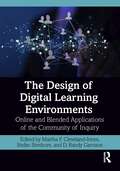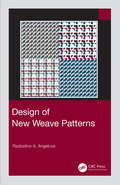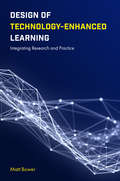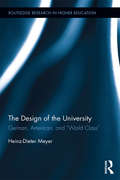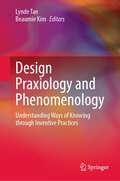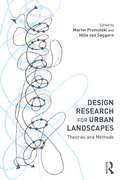- Table View
- List View
The Design of Digital Learning Environments: Online and Blended Applications of the Community of Inquiry
The Design of Digital Learning Environments provides comprehensive guidelines for creating and delivering high-quality online and blended learning experiences in higher education. With increasing numbers of students engaged in partially or fully digital education, graduate students preparing for design, development, or faculty roles need fresh, practical applications of cutting-edge research and theory. This textbook uses the Community of Inquiry framework, an influential and invaluable pedagogical model focused on deep learning, to aid educators in forging meaningful, collaborative connections with students engaged in digitally supported multi-modal learning in colleges and universities, MOOCs, and lifelong learning initiatives. Across five parts, the book covers the basic structure, concepts, terminology, and history of the Community of Inquiry; principles for designing and delivering digital courses; design for specific course conditions; applications of learning activities guided by the framework; and current limitations and directions for further research.
The Design of Educational Exhibits
by M. B. Alt D. C. Gosling Dr R Miles R. S. MilesFirst Published in 1988. Routledge is an imprint of Taylor & Francis, an informa company.
The Design of Educational Exhibits
by M. B. Alt D. C. Gosling Dr R Miles R. S. MilesFirst Published in 1988. Routledge is an imprint of Taylor & Francis, an informa company.
The Design of Future Educational Interfaces
by Sharon OviattThe Design of Future Educational Interfaces provides a new multidisciplinary synthesis of educational interface research. It explains how computer interfaces can be redesigned to better support our ability to produce ideas, think, and solve problems successfully in national priority areas such as science and mathematics. Based on first-hand research experience, the author offers a candid analysis of emerging technologies and their impact, highlighting communication interfaces that stimulate thought. The research results will surprise readers and challenge their assumptions about existing technology and its ability to support our performance. In spite of a rapid explosion of interest in educational technologies, there remains a poor understanding of what constitutes an effective educational interface for student cognition and learning. This book provides valuable insights into why recent large-scale evaluations of existing educational technologies have frequently not shown demonstrable improvements in student performance. The research presented here is grounded in cognitive science and experimental psychology, linguistic science and communications, cross-cultural cognition and language, computer science and human interface design, and the learning sciences and educational technology.
The Design of Future Educational Interfaces
by Sharon OviattThe Design of Future Educational Interfaces provides a new multidisciplinary synthesis of educational interface research. It explains how computer interfaces can be redesigned to better support our ability to produce ideas, think, and solve problems successfully in national priority areas such as science and mathematics. Based on first-hand research experience, the author offers a candid analysis of emerging technologies and their impact, highlighting communication interfaces that stimulate thought. The research results will surprise readers and challenge their assumptions about existing technology and its ability to support our performance. In spite of a rapid explosion of interest in educational technologies, there remains a poor understanding of what constitutes an effective educational interface for student cognition and learning. This book provides valuable insights into why recent large-scale evaluations of existing educational technologies have frequently not shown demonstrable improvements in student performance. The research presented here is grounded in cognitive science and experimental psychology, linguistic science and communications, cross-cultural cognition and language, computer science and human interface design, and the learning sciences and educational technology.
The Design of Instruction and Evaluation: Affordances of Using Media and Technology
by Mitchell Rabinowitz Fran C. Blumberg Howard T. EversonThis book is about empirically tested knowledge and principles that inform the design of instructional and evaluation systems, and the use and promise of media and technology within such systems. Historically, psychology has informed the design of instructional and evaluation systems in different ways. A behavioral perspective emphasizes the role of the environment in determining behavior--a factor external to the learner. A cognitive perspective focuses on the role of cognitive processing and constraints in determining learning--factors that are internal to the learner. This volume presents the affordances approach--which addresses how the environment and the affordances within it interact with cognitive processes to determine learning. Insights into this interaction are presented. It is the book's contention that the affordance approach represents an advancement over the behavioral and cognitive perspectives; it is an evolution within the cognitive approach--not an alternative to it. The Design of Instruction and Evaluation: Affordances of Using Media and Technology is intended for education practitioners responsible for the implementation of media and technology in classrooms, for researchers and faculty, and for use as a text in courses on media and technology use in educational settings, instructional design, and psychology of learning.
The Design of Instruction and Evaluation: Affordances of Using Media and Technology
by Mitchell Rabinowitz Fran C. Blumberg Howard T. EversonThis book is about empirically tested knowledge and principles that inform the design of instructional and evaluation systems, and the use and promise of media and technology within such systems. Historically, psychology has informed the design of instructional and evaluation systems in different ways. A behavioral perspective emphasizes the role of the environment in determining behavior--a factor external to the learner. A cognitive perspective focuses on the role of cognitive processing and constraints in determining learning--factors that are internal to the learner. This volume presents the affordances approach--which addresses how the environment and the affordances within it interact with cognitive processes to determine learning. Insights into this interaction are presented. It is the book's contention that the affordance approach represents an advancement over the behavioral and cognitive perspectives; it is an evolution within the cognitive approach--not an alternative to it. The Design of Instruction and Evaluation: Affordances of Using Media and Technology is intended for education practitioners responsible for the implementation of media and technology in classrooms, for researchers and faculty, and for use as a text in courses on media and technology use in educational settings, instructional design, and psychology of learning.
The Design of Learning Experience: Creating the Future of Educational Technology (Educational Communications and Technology: Issues and Innovations)
by Brad Hokanson Gregory Clinton Monica W. TraceyThis book delves into two divergent, yet parallel themes; first is an examination of how educators can design the experiences of learning, with a focus on the learner and the end results of education; and second, how educators learn to design educational products, processes and experiences. The book seeks to understand how to design how learning occurs, both in the instructional design studio and as learning occurs throughout the world. This will change the area's semantics; at a deeper level, it will change its orientation from instructors and information to learners; and it will change how educators take advantage of new and old technologies. This book is the result of a research symposium sponsored by the Association for Educational Communications and Technology [AECT].
The Design of Learning Spaces (Future Schools)
by Pamela WoolnerLearning can take place anywhere. So does the detail of the physical surroundings provided by schools matter? After many years of minimal investment in school premises, schools in the UK are in the midst of a wave of planning, building and using new schools. This includes all English secondary schools, being renewed through Building Schools for the Future (BSF), as well as schemes for English primaries and programmes of school construction in Scotland and Wales. Starting from an educational perspective, and building on work in architectural design, Pamela Woolner gives an overview of current issues in the design of learning environments, covering the physical design of spaces and how that design impacts on the organisation of people in schools, their relationships and their teaching and learning. Filling the gap in understanding and knowledge between the worlds of architecture and education, this is essential reading for school leaders and all those engaged in thinking about how school design might be planned and arranged to facilitate learning and teaching.
The Design of Learning Spaces (Future Schools)
by Pamela WoolnerLearning can take place anywhere. So does the detail of the physical surroundings provided by schools matter? After many years of minimal investment in school premises, schools in the UK are in the midst of a wave of planning, building and using new schools. This includes all English secondary schools, being renewed through Building Schools for the Future (BSF), as well as schemes for English primaries and programmes of school construction in Scotland and Wales. Starting from an educational perspective, and building on work in architectural design, Pamela Woolner gives an overview of current issues in the design of learning environments, covering the physical design of spaces and how that design impacts on the organisation of people in schools, their relationships and their teaching and learning. Filling the gap in understanding and knowledge between the worlds of architecture and education, this is essential reading for school leaders and all those engaged in thinking about how school design might be planned and arranged to facilitate learning and teaching.
Design of New Weave Patterns
by Radostina A. AngelovaThis book presents a systematic study on methods used for the creation of weave patterns for simple structures. Firstly, it explains known techniques for designing new weave patterns classified as patterns merge, motifs, patterns insertion and change of the displacement number. These are discussed as possibilities to create different textures and weaving effects supported by figures of patterns, colour view, and fabric appearance simulation. Secondly, it explains original methods for design of new weave patterns based on Boolean operations, musical scores, written texts and braille alphabet, including transformations performed, advantages/disadvantages, possible applications and designs.
Design of New Weave Patterns
by Radostina A. AngelovaThis book presents a systematic study on methods used for the creation of weave patterns for simple structures. Firstly, it explains known techniques for designing new weave patterns classified as patterns merge, motifs, patterns insertion and change of the displacement number. These are discussed as possibilities to create different textures and weaving effects supported by figures of patterns, colour view, and fabric appearance simulation. Secondly, it explains original methods for design of new weave patterns based on Boolean operations, musical scores, written texts and braille alphabet, including transformations performed, advantages/disadvantages, possible applications and designs.
Design of Technology-Enhanced Learning: Integrating Research and Practice
by Matt BowerEducators and researchers worldwide are confronted by a tantalizing challenge – how should contemporary technologies be used to enhance learning? This book provides a broad academic and teaching audience with an integrated understanding of learning technology research, and how it can be used to enhance the design of learning environments. Whereas some books focus exclusively on research relating to learning technology and others propose ways to use technology effectively, this book synthesises research for the purpose of informing best practice. After laying pedagogical, technological and content foundations, it examines research relating to the educational use of Web 2.0, social networking, mobile devices and virtual worlds. Analysis across these contexts leaves readers with a nuanced understanding of how technology-enhanced learning design principles may (or may not) be abstracted across different learning technology environments. Providing an integrated portrayal of learning technology research enables educators (academics, school teachers, pre-service teachers and educational designers) to immediately adopt evidence-based approaches in their teaching. The comprehensive synthesis of the literature also helps learning technology researchers to more clearly identify the interrelationships between different areas of learning technology research, as well as position their work amongst the practical problems of the field. Rich with examples, this book is suitable for those who want to adopt a design-based and research-driven approach to enhancing learning using technology.
Design of Technology-Enhanced Learning: Integrating Research and Practice
by Matt BowerEducators and researchers worldwide are confronted by a tantalizing challenge – how should contemporary technologies be used to enhance learning? This book provides a broad academic and teaching audience with an integrated understanding of learning technology research, and how it can be used to enhance the design of learning environments. Whereas some books focus exclusively on research relating to learning technology and others propose ways to use technology effectively, this book synthesises research for the purpose of informing best practice. After laying pedagogical, technological and content foundations, it examines research relating to the educational use of Web 2.0, social networking, mobile devices and virtual worlds. Analysis across these contexts leaves readers with a nuanced understanding of how technology-enhanced learning design principles may (or may not) be abstracted across different learning technology environments. Providing an integrated portrayal of learning technology research enables educators (academics, school teachers, pre-service teachers and educational designers) to immediately adopt evidence-based approaches in their teaching. The comprehensive synthesis of the literature also helps learning technology researchers to more clearly identify the interrelationships between different areas of learning technology research, as well as position their work amongst the practical problems of the field. Rich with examples, this book is suitable for those who want to adopt a design-based and research-driven approach to enhancing learning using technology.
The Design of the University: German, American, and “World Class” (Routledge Research in Higher Education)
by Heinz-Dieter MeyerWhat is the reason for the American university’s global preeminence? How did the American university succeed where the development of the German university, from which it took so much, stalled? In this closely-argued book, Meyer suggests that the key to the American university’s success is its institutional design of self-government. Where other university systems are dependent on the patronage of state, church, or market, the American university is the first to achieve true autonomy, which it attained through an intricate system of engagements with societal actors and institutions that simultaneously act as amplifiers of its impact and as checks on the university’s ever-present corrosive tendencies. Built on a searching analysis of the design thinking of Wilhelm von Humboldt and Adam Smith and closely tracing the learning process by which Americans adapted the German model, The Design of the University dismisses efforts to copy superficial features of the American university in order to achieve world-class rank. Calling attention to the design details of the university and the particulars of its institutional environment, this volume identifies the practices and choices that produced the gold standard for today’s world class higher education.
The Design of the University: German, American, and “World Class” (Routledge Research in Higher Education #26)
by Heinz-Dieter MeyerWhat is the reason for the American university’s global preeminence? How did the American university succeed where the development of the German university, from which it took so much, stalled? In this closely-argued book, Meyer suggests that the key to the American university’s success is its institutional design of self-government. Where other university systems are dependent on the patronage of state, church, or market, the American university is the first to achieve true autonomy, which it attained through an intricate system of engagements with societal actors and institutions that simultaneously act as amplifiers of its impact and as checks on the university’s ever-present corrosive tendencies. Built on a searching analysis of the design thinking of Wilhelm von Humboldt and Adam Smith and closely tracing the learning process by which Americans adapted the German model, The Design of the University dismisses efforts to copy superficial features of the American university in order to achieve world-class rank. Calling attention to the design details of the university and the particulars of its institutional environment, this volume identifies the practices and choices that produced the gold standard for today’s world class higher education.
Design Pedagogy: Developments in Art and Design Education
by Mike ToveyDesign Pedagogy explains why it is vital for design students that their education helps them construct a ’passport’ to enter the professional sphere. Recent research into design teaching has focused on its signature pedagogies, those elements which are particularly characteristic of the disciplines. Typically based on core design theory, enlivened by approaches imported to the area, such work has utility when it recognizes the visual language of designing, the media of representation used, and the practical realities of tackling design questions. Increasingly the 21st century sees these activities in a global context where the international language of the visual artefact is recognized. This book draws on recent work in these areas. It includes a number of chapters which are developed from work undertaken during the period of special funding for centres of teaching excellence in the UK up until 2010. Two of those in design have provided the basis for research and innovative developments reported on here. They have helped to enliven the environment for design pedagogy research in other establishments which are also included. Design students need support for the agile navigation through the design process. Learning experiences should develop students’ natural motivations and professionalise motivation to create a resilient, informed and sustainable capacity. This is the essence of ’transformative learning’. This collection explores how design education is, in itself, a passport to practice and showcases how some of the key developments in education use techniques related to collaboration, case studies and experience to motivate students, enable them to express their identity, reflect and learn.
Design Pedagogy: Developments in Art and Design Education
by Mike ToveyDesign Pedagogy explains why it is vital for design students that their education helps them construct a ’passport’ to enter the professional sphere. Recent research into design teaching has focused on its signature pedagogies, those elements which are particularly characteristic of the disciplines. Typically based on core design theory, enlivened by approaches imported to the area, such work has utility when it recognizes the visual language of designing, the media of representation used, and the practical realities of tackling design questions. Increasingly the 21st century sees these activities in a global context where the international language of the visual artefact is recognized. This book draws on recent work in these areas. It includes a number of chapters which are developed from work undertaken during the period of special funding for centres of teaching excellence in the UK up until 2010. Two of those in design have provided the basis for research and innovative developments reported on here. They have helped to enliven the environment for design pedagogy research in other establishments which are also included. Design students need support for the agile navigation through the design process. Learning experiences should develop students’ natural motivations and professionalise motivation to create a resilient, informed and sustainable capacity. This is the essence of ’transformative learning’. This collection explores how design education is, in itself, a passport to practice and showcases how some of the key developments in education use techniques related to collaboration, case studies and experience to motivate students, enable them to express their identity, reflect and learn.
Design Praxiology and Phenomenology: Understanding Ways of Knowing through Inventive Practices
by Lynde Tan Beaumie KimThis book offers insight into designerly ways of knowing from the perspectives of experts and professionals engaging in diverse forms of design in workplaces and other public domains. It also aids in the understanding of design practices from designers’ viewpoints via case studies. By pursuing a reflective inquiry in their design epistemology (designerly ways of knowing), design praxiology (practices of design), or design phenomenology (forms of designs), self-studies of design practices, and presenting studies of designs, the authors of this book demonstrate how they influence the people and the object of inquiry or design. The case studies presented in this book also illustrate how designers develop their expertise, and provides inspiration for the incorporation of design-thinking and practice in education.
Design Principles for Photography
by Jeremy WebbIn an age over-saturated with photographic imagery, Design Principles for Photography demonstrates how design awareness can add a new level of depth to your images. By adapting and experimenting with the tried and tested techniques used by graphic designers every day, you can add dynamism and impact to your imagery, whatever the style or genre - something that today's editors, curators and publishers are all crying out for.The second edition includes examples of unsuccessful compositions, annotated images highlighting key techniques and an expanded glossary. There’s also a new section on movements in photography and their reflection in composition, including modernism, expressionism, and surrealism and interviews with international practitioners discussing how they’ve included design principles in their work. Featured topics: Basic design theory; the use of space; positional decisions; the elements of design; line; shape or form; space; texture; light; colour; pattern; rhythm; contrast; scale and proportion; abstraction; movement and flow; containment; emphasis and emotion; justaposition; incongruity; mood and emotion.
Design Principles for Photography
by Jeremy WebbIn an age over-saturated with photographic imagery, Design Principles for Photography demonstrates how design awareness can add a new level of depth to your images. By adapting and experimenting with the tried and tested techniques used by graphic designers every day, you can add dynamism and impact to your imagery, whatever the style or genre - something that today's editors, curators and publishers are all crying out for.The second edition includes examples of unsuccessful compositions, annotated images highlighting key techniques and an expanded glossary. There’s also a new section on movements in photography and their reflection in composition, including modernism, expressionism, and surrealism and interviews with international practitioners discussing how they’ve included design principles in their work. Featured topics: Basic design theory; the use of space; positional decisions; the elements of design; line; shape or form; space; texture; light; colour; pattern; rhythm; contrast; scale and proportion; abstraction; movement and flow; containment; emphasis and emotion; justaposition; incongruity; mood and emotion.
Design Realities: Creativity, Nature and the Human Spirit
by Stuart WalkerDesign Realities explores a wide range of topics on creativity, design and spiritual well-being. Using critique, rational inquiry and personal reflection, Stuart Walker looks squarely at our contemporary condition, demonstrates how current assumptions and material expectations are becoming untenable and, most importantly, offers constructive new directions that are feasible, spiritually enriching, and hopeful. Comprising short essays, lyrical pieces, photo studies and longer discourses, this book takes us on a highly readable and enjoyable journey through some of the most pressing issues of our time. The innovative, intuitive format makes these topics readily accessible, while providing much food for thought about the changing nature of creativity in today’s world. Written by a leading thinker in the field, this highly original book offers readers something to ponder, discuss, contest and build upon.
Design Realities: Creativity, Nature and the Human Spirit
by Stuart WalkerDesign Realities explores a wide range of topics on creativity, design and spiritual well-being. Using critique, rational inquiry and personal reflection, Stuart Walker looks squarely at our contemporary condition, demonstrates how current assumptions and material expectations are becoming untenable and, most importantly, offers constructive new directions that are feasible, spiritually enriching, and hopeful. Comprising short essays, lyrical pieces, photo studies and longer discourses, this book takes us on a highly readable and enjoyable journey through some of the most pressing issues of our time. The innovative, intuitive format makes these topics readily accessible, while providing much food for thought about the changing nature of creativity in today’s world. Written by a leading thinker in the field, this highly original book offers readers something to ponder, discuss, contest and build upon.
Design Research for Urban Landscapes: Theories and Methods
by Martin Prominski Hille SeggernWithin the spatial design disciplines, research through design as a tool and practice has often been neglected. This book provides a much-needed companion to the theories, methods and processes involved in using design-based research in landscape, architecture and urban design. Aimed specifically at researchers completing PhD projects, supervisors and designers working in practice, it covers applied approaches to help you to use design research in your work. With fully illustrated examples of original international design research PhDs from a variety of programme types, such as individual, structured and practice-based, Design Research for Urban Landscapes offers PhD candidates and supervisors a clear foundational pathway.
Design Research for Urban Landscapes: Theories and Methods
by Martin Prominski Hille SeggernWithin the spatial design disciplines, research through design as a tool and practice has often been neglected. This book provides a much-needed companion to the theories, methods and processes involved in using design-based research in landscape, architecture and urban design. Aimed specifically at researchers completing PhD projects, supervisors and designers working in practice, it covers applied approaches to help you to use design research in your work. With fully illustrated examples of original international design research PhDs from a variety of programme types, such as individual, structured and practice-based, Design Research for Urban Landscapes offers PhD candidates and supervisors a clear foundational pathway.
